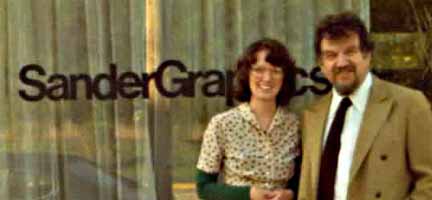
Dave’s father, Jacob Sander, owned a very prosperous commercial wood engraving company in Chicago. Chicago, as a center for the 19th century publishing and mail-order catalog trade, was also a center for commercial wood engraving. Before photo-reproduction was invented, wood engravings illustrated all the Sears Roebuck and Montgomery Wards catalogs as well as most books and periodicals.
After photo-reproduction became commonplace, the Sander firm continued in a small way, marketing wood engraved images for specialty illustration purposes. Finally, it expired as a commercially viable venture. The introduction to Dave’s book, Wood Engraving; An Adventure in Printmaking (The Viking Press, New York, 1978), includes some charming tales of his childhood experiences at his father’s firm, along with the story of its demise. At that time, Dave moved the remnants of the business -- presses, tools and other equipment -- into the Porter building, which was close to his home. I do not know exactly what year that took place. When I joined Dave, he was simultaneously running a small local advertising agency and a business to promote wood engraving as a printmaking medium. He assembled a huge collection of books and periodicals illustrated with wood engravings. These volumes provided art for his advertising promotions, as well as a reference library for the wood engraving business. It was my great pleasure to spend many hours organizing and examining the library. He also issued a wood engraving tool and supply catalog and offered summer workshops to teach wood engraving.
He corresponded with many American and European wood engravers, as this was a time when wood engraving was re-emerging as a “new” medium for fine printmaking, small letterpresses, and illustrators. Some of these individuals were experienced wood engravers, well-established artists and illustrators such as Leonard Baskin, John De Pol and Claire Leighton. Some, like Barry Moser, were younger, emerging practitioners. Some were new to the wood-engraving media, others were older contacts from the commercial trade who continued to engrave in their retirement.
I worked with Dave to establish a gallery of wood engraving prints, and to assist in the preparation of his book. In 1978 I moved to New York City to pursue a graduate degree in communication design at Pratt Institute. I carried with me a collection of tools that I had purchased from the widow of Chicago wood engraver Charles Mulac, along with a number of letterpress items. A wood engraving proof by Mr. Mulac in my possession indicates that he began his career in wood and photo engraving on August 20, 1920, and retired on November 28, 1969.
Finally, last summer, I admitted to myself that I would never continue to pursue wood engraving in any active way. Yet I wanted to insure that the tools would be accessible to interested printmakers -- not discarded or sold as antique curiosities. After an internet search to locate an appropriate local non-profit beneficiary, I donated the collection to the Book Arts League. Though I never achieved any measure of proficiency in wood engraving myself, my interest in its history continues. Through this donation, I hope that future generations of aspiring young wood engravers can make good use of these tools. They are a small legacy from a previous generation of wood engravers now gone from the earth.
—Diane Wray
